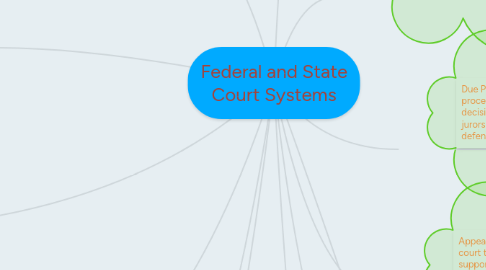Federal and State Court Systems
Emily Rensiにより

1. State and Local Courts: State and local courts interpret and apply state and local laws. State courts decide most cases involving state law, which include most criminal, family, contract, and juvenile law cases. Local courts are part of their state court system and decide cases involving local laws, like those concerning littering or parking violations.
2. State Trial and Appeals Courts: State court systems vary in their structure but generally have three types of courts: minor courts, general trial courts, and appeals courts. The names of these courts often vary.
3. Judges: There are about 30,000 state court judges in the United States. These judges are selected in four different ways: popular election, election by the legislature, appointment by the governor, or by a combination of appointment and popular election
4. Federal Courts: Article III of the U.S. Constitution sets out the basic structure of the federal court system. The Constitution creates a Supreme Court and gives Congress the power to create lower courts. The federal courts are considered to be courts of limited jurisdiction, just as the federal government is a government of limited, enumerated powers. federal courts handle more than 375,000 cases per year; this figure does not include the more than 1,000,000 bankruptcy petitions federal courts handle annually.
5. Other Courts: Two other types of courts that operate in the United States are military courts that administer justice and tribal courts that operate on Native American reservations.
6. Military Courts: Article I, Section 8, of the U.S. Constitution gives Congress the authority to “make rules for the government and regulation of the land and naval forces.” This allowed Congress to develop a separate justice system specifically for the U.S. military that is overseen by the president as the commander in chief of the armed forces.
7. Tribal Courts: Several hundred Native American tribal groups govern reservations in the United States. Most of these groups have tribal justice systems. Tribal courts hear a broad range of both criminal and civil cases involving both Native Americans and non-Native Americans
8. Appeals: An individual who loses a case in a trial court may wish to appeal that decision.
9. Errors of Law: In our legal system, questions about the facts of a case are decided at trial. Trial judges and juries hear testimony, review evidence, and are in the best position to determine the credibility of the witnesses.Appeals are possible when the losing party can claim that the trial court made an error of law.
10. Due Process: The fair administration of justice is called procedural due process. Fair procedures help prevent arbitrary, unreasonable decisions. Due process also ensures that police, lawyers, judges, and jurors must follow the same basic procedures regardless of the defendant.
11. Appeals Court: In an appeals court, one party presents arguments asking the court to review the decision of the trial court; the other party presents arguments supporting the decision of the trial court and the procedures it followed. There are no juries or witnesses in an appeals court, and no new evidence is presented. Only lawyers appear before the judges to make legal arguments.
12. Precedent and Stare Decisis: When an appeals court decides a case, one of the things judges consider is precedent. Following precedent is an important part of our legal system. This basic legal principle is often called stare decisis
13. Jurisdiction: The United States has many, many courts. Each of the 50 states and the District of Columbia has a court system; there is a federal court system, and there are also military courts as well as a number of tribal justice systems.


